WWI Propaganda and Art
Making Connections
All documents and text associated with this activity are printed below, followed by a worksheet for student responses.Introduction
Propaganda promotes ideas and beliefs for others to adopt. It can take many forms: speeches, writing, or images. It can be deceitful and subversive, or encouraging. There were many uses of propaganda during World War I, including building up support for the war at home. The Committee for Public Information (CPI), an organization created by President Woodrow Wilson, hired 8 civilian artists to document the American troops in Europe for publication in popular magazines. Analyze the documents and images you will see. Answer the questions to explore the conflict between the artists, the CPI, and the Army about how the artists presented the war for an American audience.Name:
Class:
Class:
Worksheet
WWI Propaganda and Art
Making Connections
Examine the documents and text included in this activity. Fill in any blanks in the sequence with your thoughts and write your conclusion response in the space provided.The first document is a memo about the work of the civilian (non-military personnel) artists who were assigned to the American Expeditionary Forces (the U.S. Armed Forces sent to fight in Europe during WWI), also known as AEF. As you read it, think about these questions and then answer them in the blank box that follows:
Who issued this memo? (Hint: What do you think G.H.Q. stands for?)
What obstacles did they anticipate standing in the way of the artists’ success?
What obstacles do you think they failed to think of that could have prevented the artists from completing their work?
Who issued this memo? (Hint: What do you think G.H.Q. stands for?)
What obstacles did they anticipate standing in the way of the artists’ success?
What obstacles do you think they failed to think of that could have prevented the artists from completing their work?
General Policy Reference the Work of Official Artists
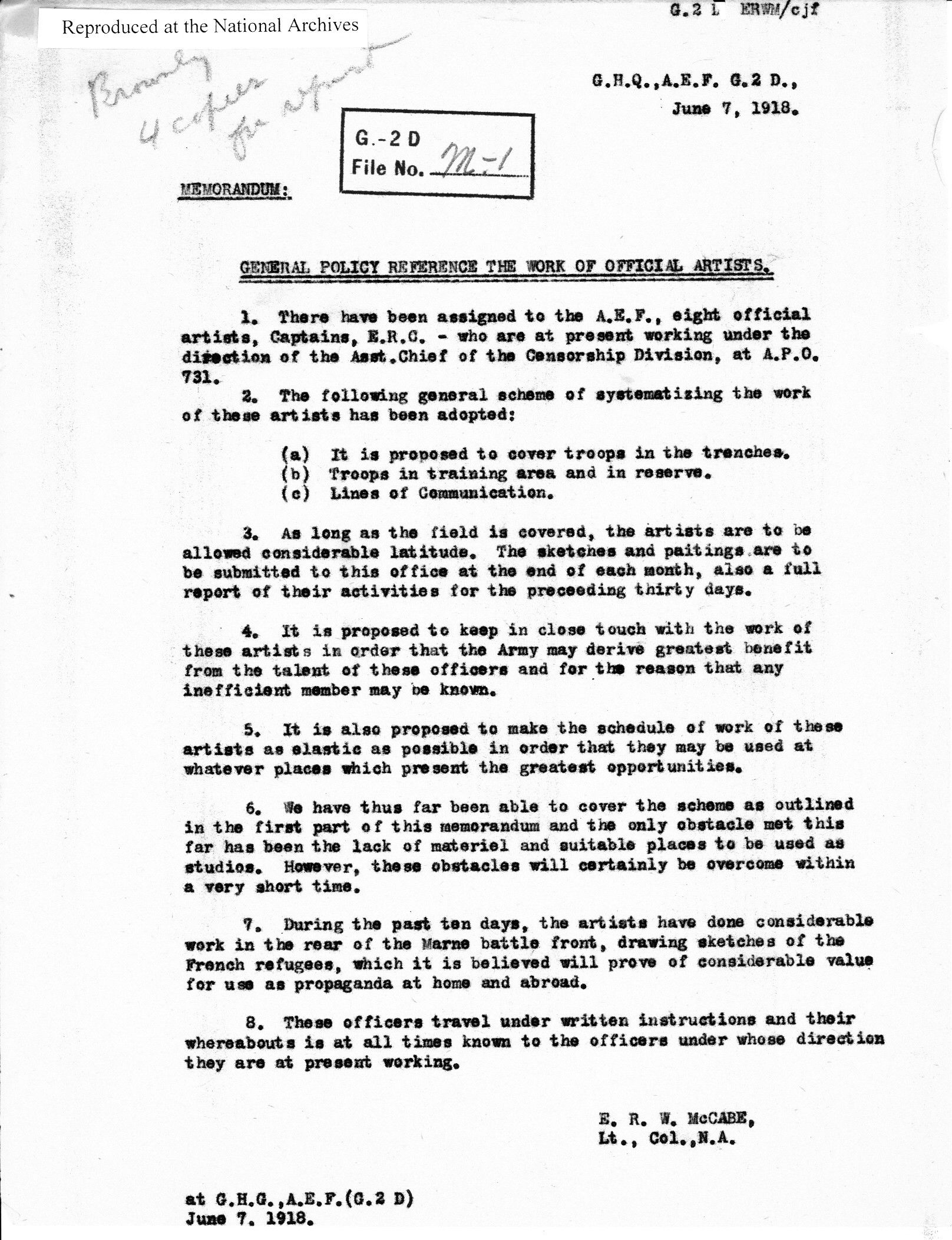
Enter your response
Analyze this complaint and answer these questions in the blank box that follows:
How is art by U.S. and French war artists compared?
What goal of the U.S. Army are the artists failing to achieve, in the Army’s opinion?
How is art by U.S. and French war artists compared?
What goal of the U.S. Army are the artists failing to achieve, in the Army’s opinion?
Complaint from Major, N.A., to Captain Smith

Enter your response
Analyze this cablegram and look at the example artwork. Answer these questions in the blank box:
Why is American war art deemed “unsatisfactory”?
How is the art to be used?
Why is American war art deemed “unsatisfactory”?
How is the art to be used?
Cablegram from the Acting Adjutant General
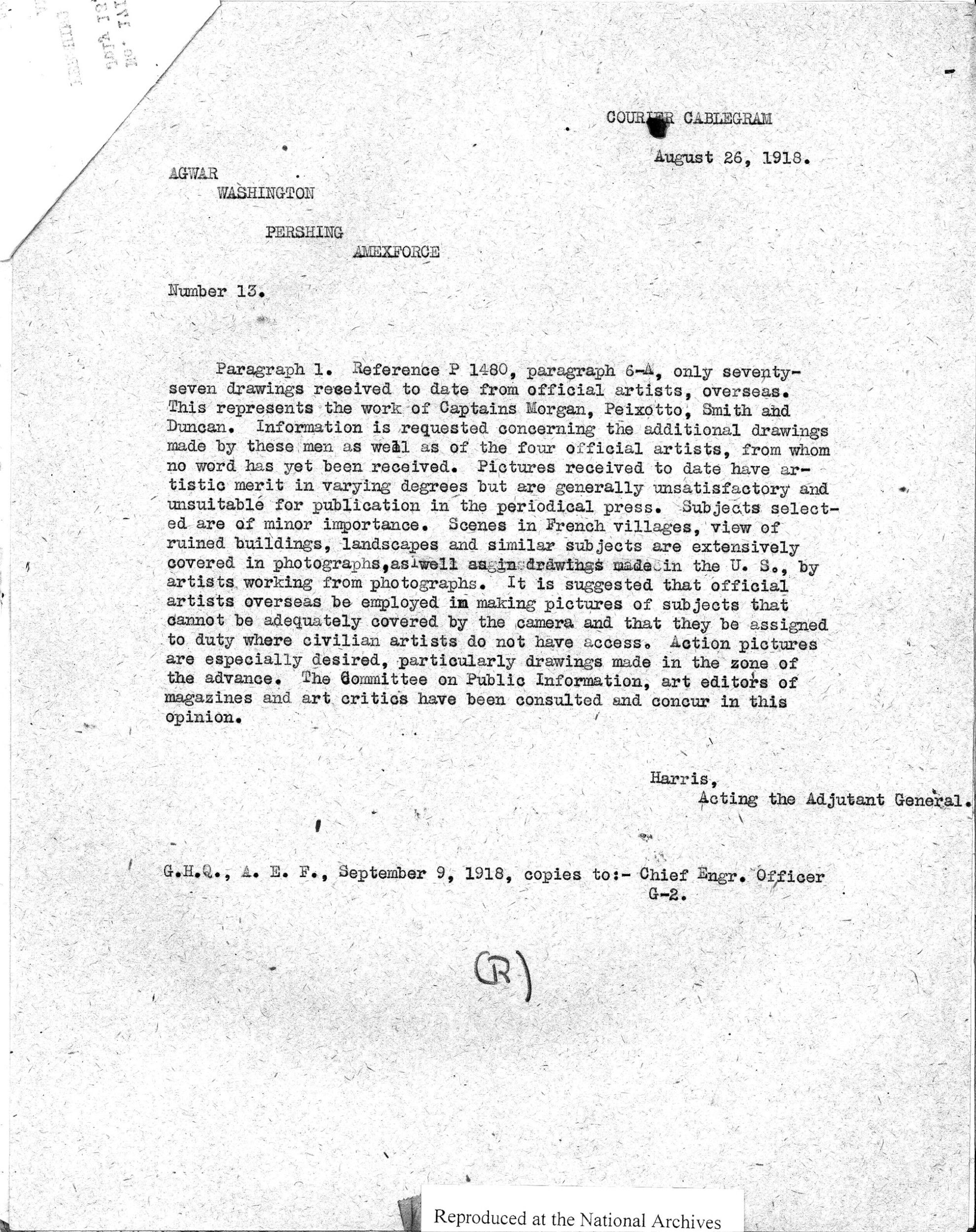
The River at Neufchateau
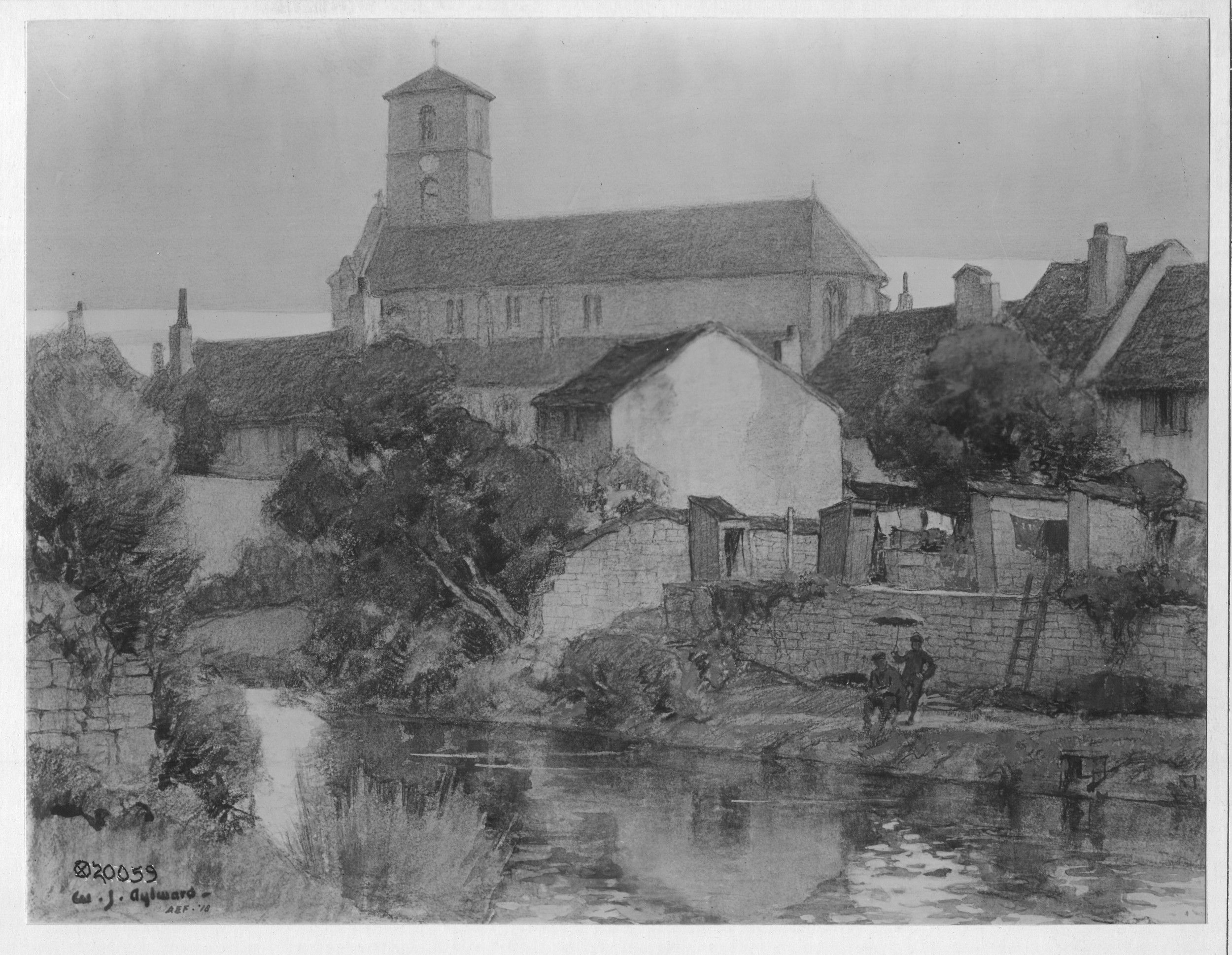
Enter your response
Analyze this memo and answer this question in the blank box:
How do the artists themselves explain why they are not producing “battle” art?
How do the artists themselves explain why they are not producing “battle” art?
Memo from Captain William E. Moore to Chief, G-2-D
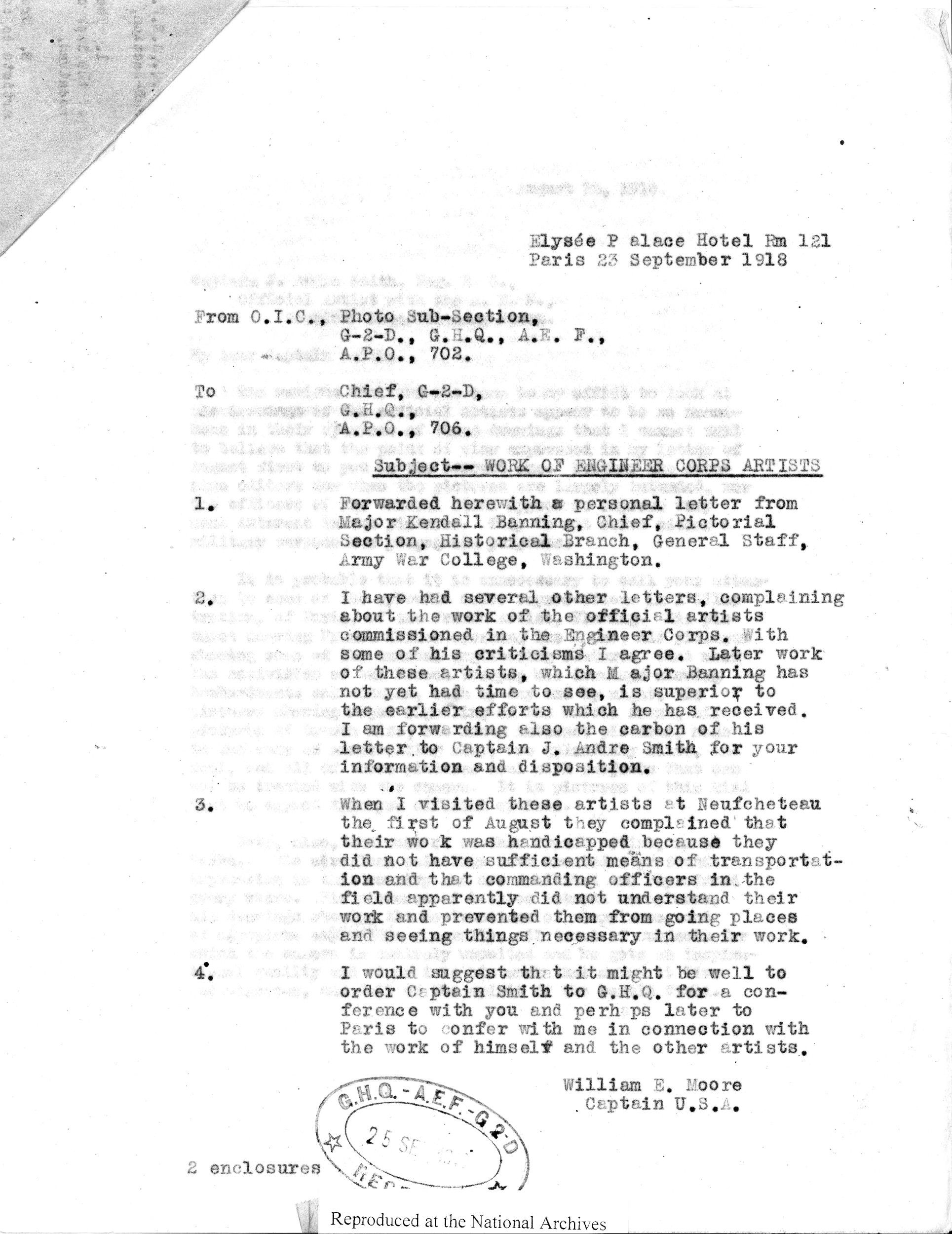
Enter your response
General John J. Pershing led the American Expeditionary Forces (AEF). Analyze his memo and the artwork. Answer:
What goal besides propaganda can war art serve?
How does Pershing establish rules for artists in combat?
What might have been his motivation?
What goal besides propaganda can war art serve?
How does Pershing establish rules for artists in combat?
What might have been his motivation?
Rough Draft of Memo for Chief of Staff from Pershing
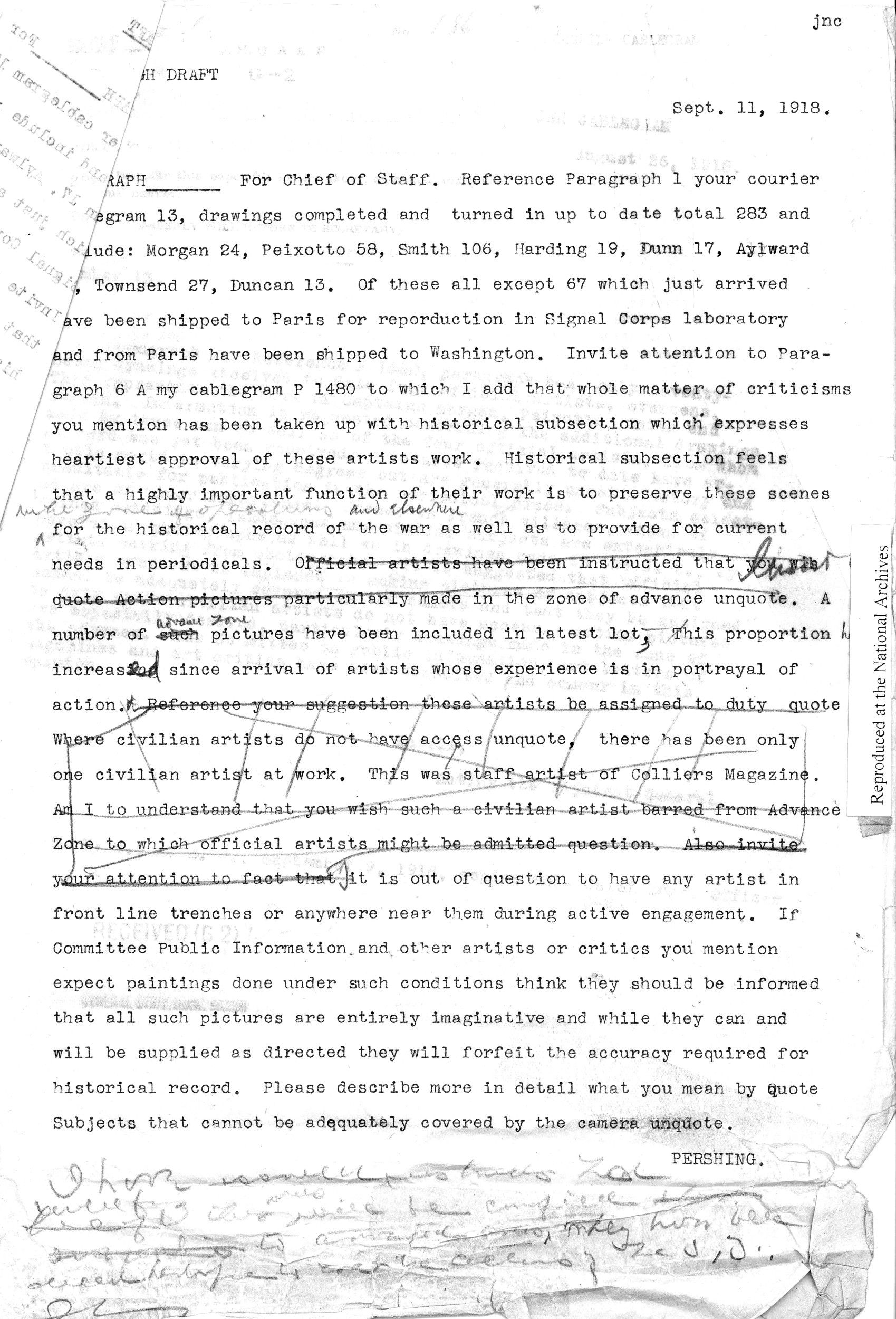
Doughboy Fighting Through Barbed Wire Entanglements
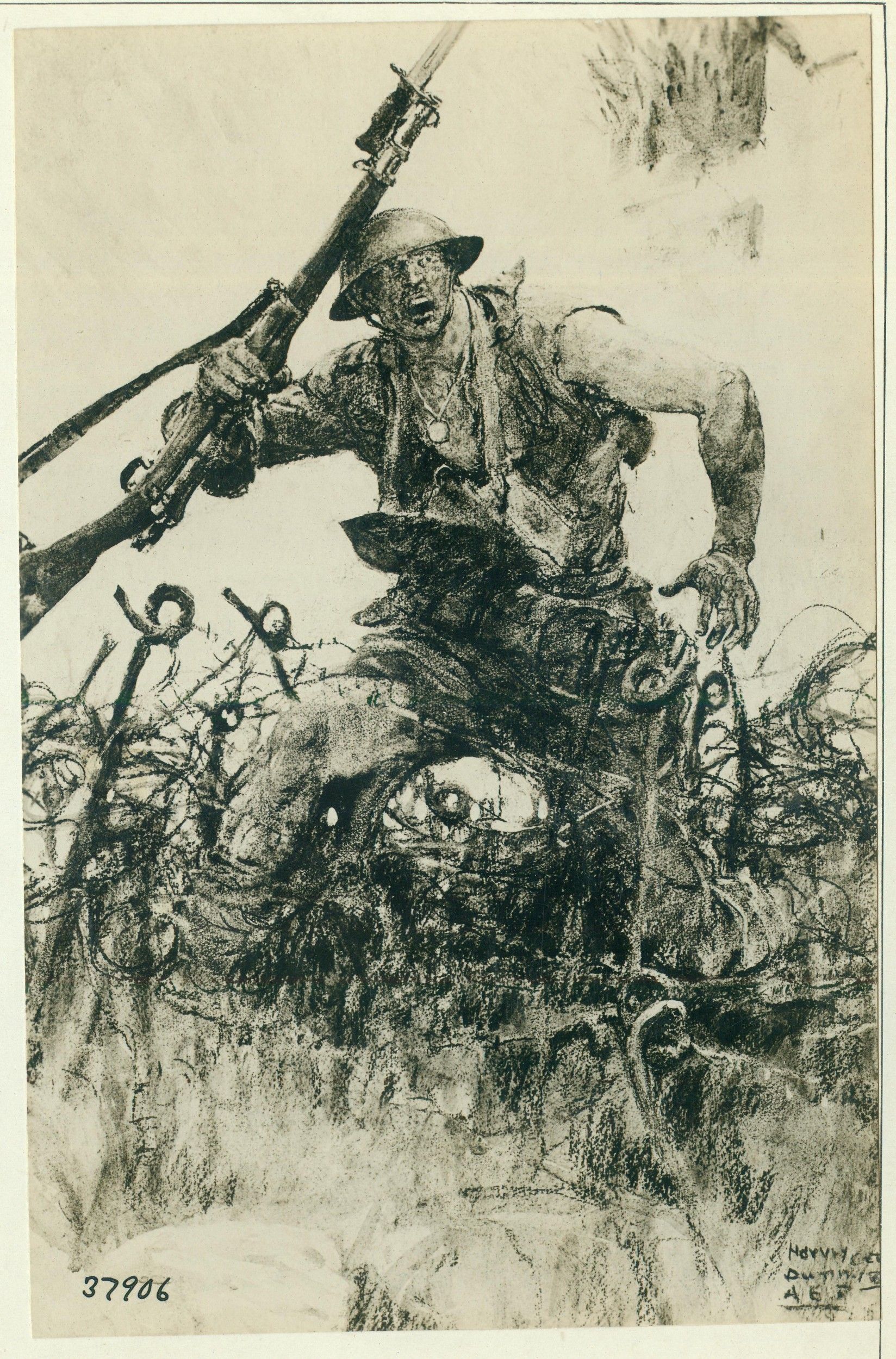
Enter your response
1
Activity Element
General Policy Reference the Work of Official Artists
Page 1

2
Activity Element
Complaint from Major, N.A., to Captain Smith
Page 1

3
Activity Element
Cablegram from the Acting Adjutant General
Page 1

4
Activity Element
The River at Neufchateau
Page 1

5
Activity Element
Memo from Captain William E. Moore to Chief, G-2-D
Page 1

6
Activity Element
Rough Draft of Memo for Chief of Staff from Pershing
Page 1

7
Activity Element
Doughboy Fighting Through Barbed Wire Entanglements
Page 1

Conclusion
WWI Propaganda and Art
Making Connections
Answer the following:- How did the subject of the art change over time?
- What factors explain the change?
- Do you think that civilians should be embedded (assigned to travel with military units) during war? Why or why not?
- How do you think changes in technology have affected how civilians embedded in military units do their jobs documenting or reporting on wars today?
Your Response
Document
General Policy Reference the Work of Official Artists
6/7/1918
During World War I, the U.S. Government’s Committee for Public Information employed artists, who followed troops into France with the American Expeditionary Forces (AEF) during the war. Commissioned as officers in the Corps of Engineers, the artists were assigned to create artwork in a variety of media to show the war to Americans back home.
The artists were required to submit their work on a regular basis to the Army, as outlined in this document. Artwork was sent to the headquarters in France before being sent on to Washington D.C., where the incoming sketches were reviewed to determine if the artists were producing work that met the Army’s requirements.
The artists were required to submit their work on a regular basis to the Army, as outlined in this document. Artwork was sent to the headquarters in France before being sent on to Washington D.C., where the incoming sketches were reviewed to determine if the artists were producing work that met the Army’s requirements.
This primary source comes from the Records of the American Expeditionary Forces (World War I).
Full Citation: General Policy Reference the Work of Official Artists; 6/7/1918; Correspondence Relating to the Eight Official Artists of the AEF, 1917 -1919; General Headquarters: General Staff: G-2: Censorship and Press Division (G-2-D); Records of the American Expeditionary Forces (World War I), ; National Archives at College Park, College Park, MD. [Online Version, https://www.docsteach.org/documents/document/policy-official-artists, April 20, 2024]General Policy Reference the Work of Official Artists
Page 1
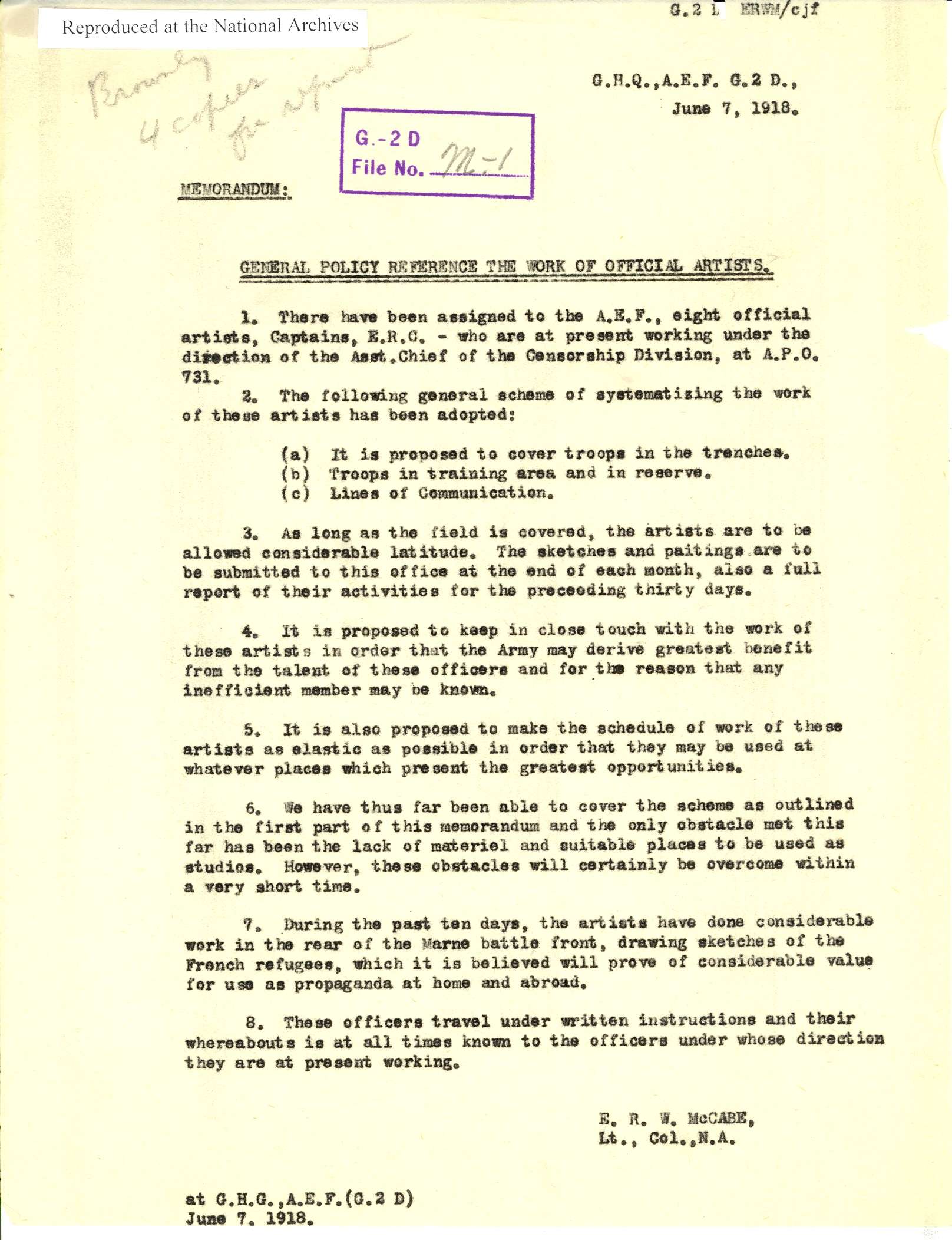
Document
Complaint from Major, N.A., to Captain Smith
8/13/1918
This primary source comes from the Records of the American Expeditionary Forces (World War I).
National Archives Identifier: 16569059
Full Citation: Complaint from Major, N.A., to Captain Smith; 8/13/1918; Records of the American Expeditionary Forces (World War I), . [Online Version, https://www.docsteach.org/documents/document/complaint-from-major-na-to-captain-smith, April 20, 2024]Complaint from Major, N.A., to Captain Smith
Page 1
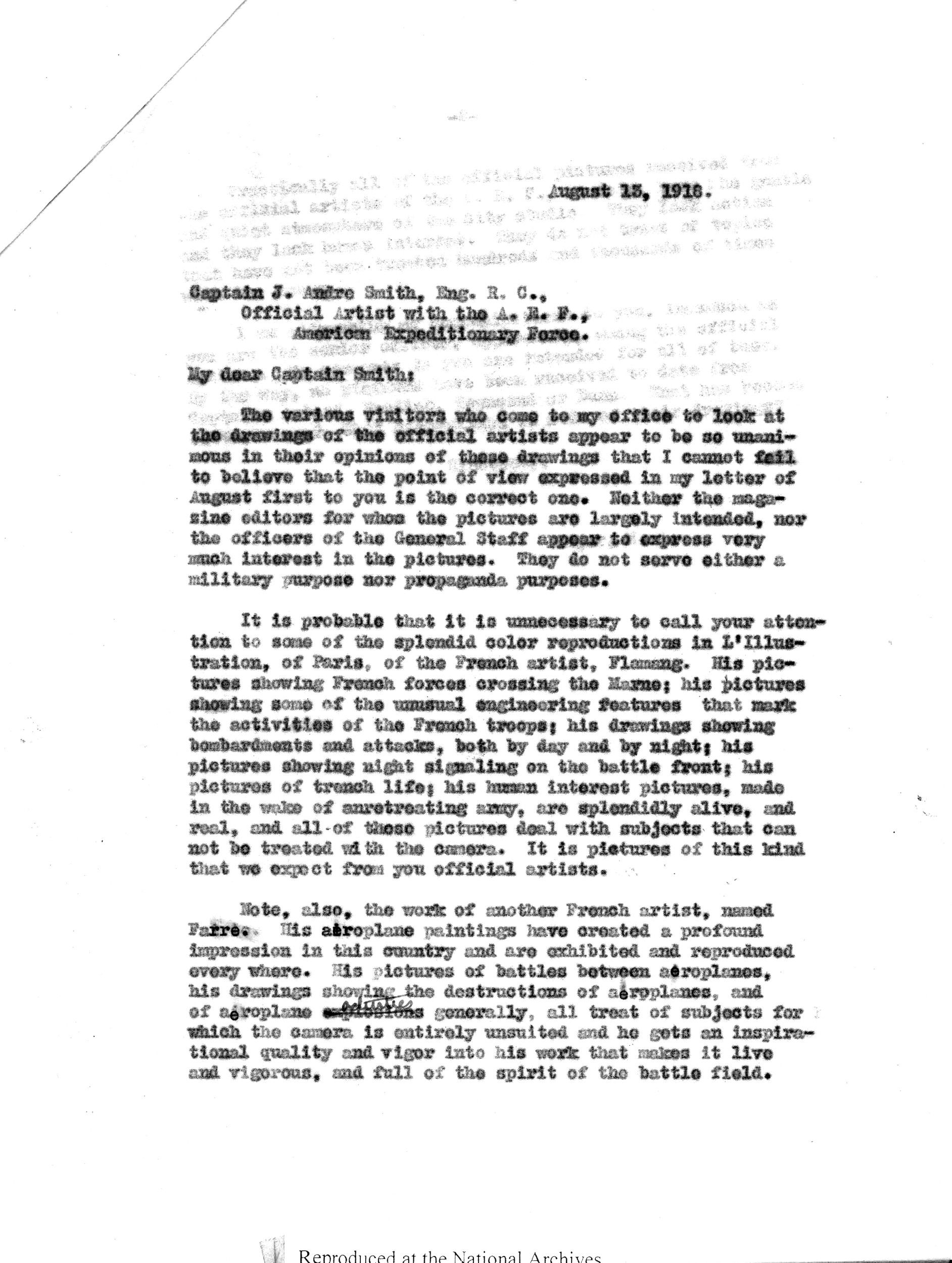
Complaint from Major, N.A., to Captain Smith
Page 2

Document
Cablegram from the Acting Adjutant General
8/26/1918
This primary source comes from the Records of the American Expeditionary Forces (World War I).
National Archives Identifier: 16569277
Full Citation: Cablegram from the Acting Adjutant General; 8/26/1918; Records of the American Expeditionary Forces (World War I), . [Online Version, https://www.docsteach.org/documents/document/cablegram-from-the-acting-adjutant-general, April 20, 2024]Cablegram from the Acting Adjutant General
Page 1
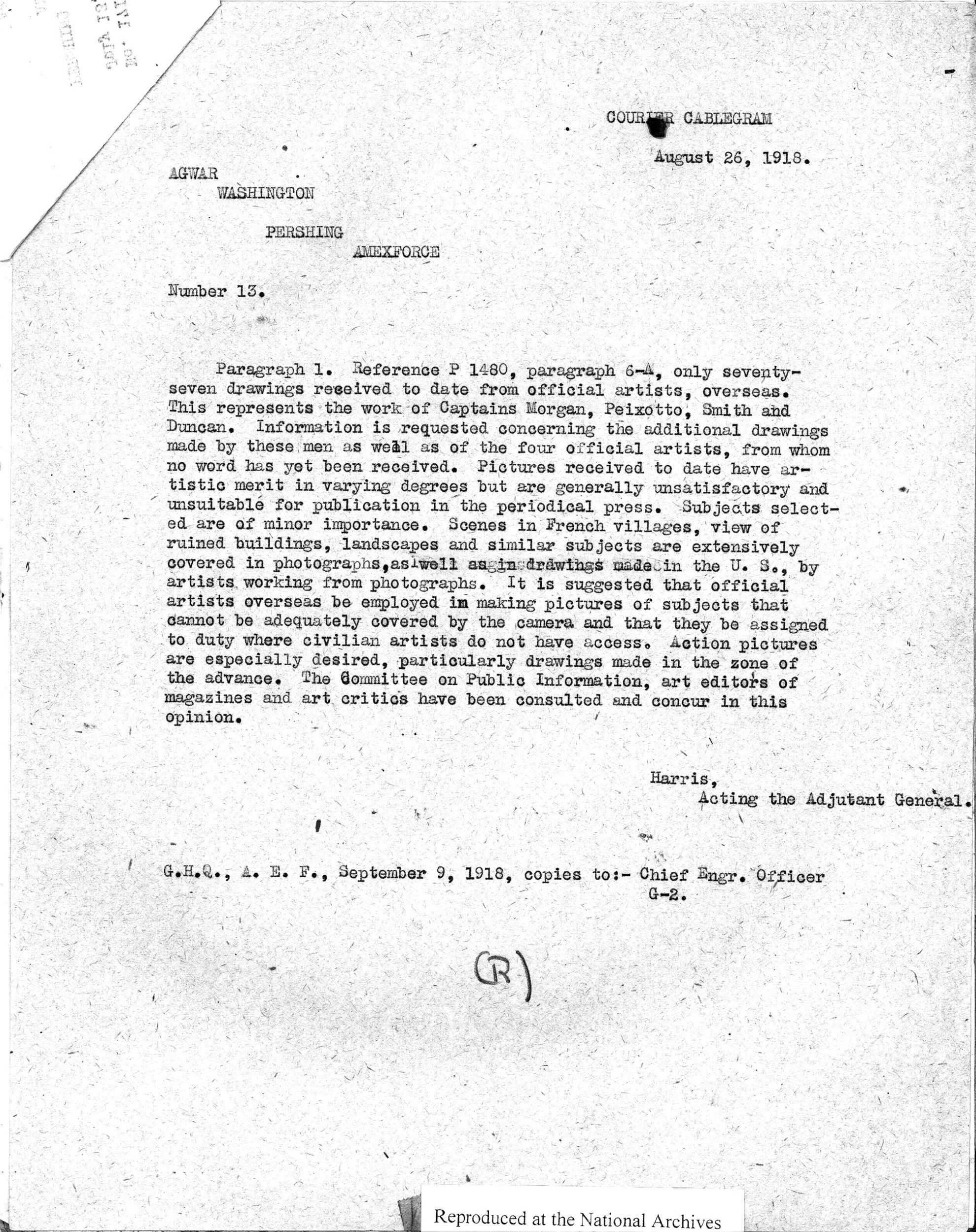
Document
The River at Neufchateau
1918
During World War I, the U.S. Government’s Committee for Public Information employed artists, who followed troops into France with the American Expeditionary Forces (AEF) during the war. Commissioned as officers in the Corps of Engineers, the artists were assigned to create artwork in a variety of media to show the war to Americans back home.
Official American military artist Capt. W.J. Aylward made this drawing.
Official American military artist Capt. W.J. Aylward made this drawing.
This primary source comes from the Records of the Office of the Chief Signal Officer.
National Archives Identifier: 12060632
Full Citation: Photograph 111-SC-20059; The River at Neufchateau; 1918; Photographs of American Military Activities, ca. 1918 - ca. 1981; Records of the Office of the Chief Signal Officer, ; National Archives at College Park, College Park, MD. [Online Version, https://www.docsteach.org/documents/document/river-neufchateau, April 20, 2024]The River at Neufchateau
Page 1
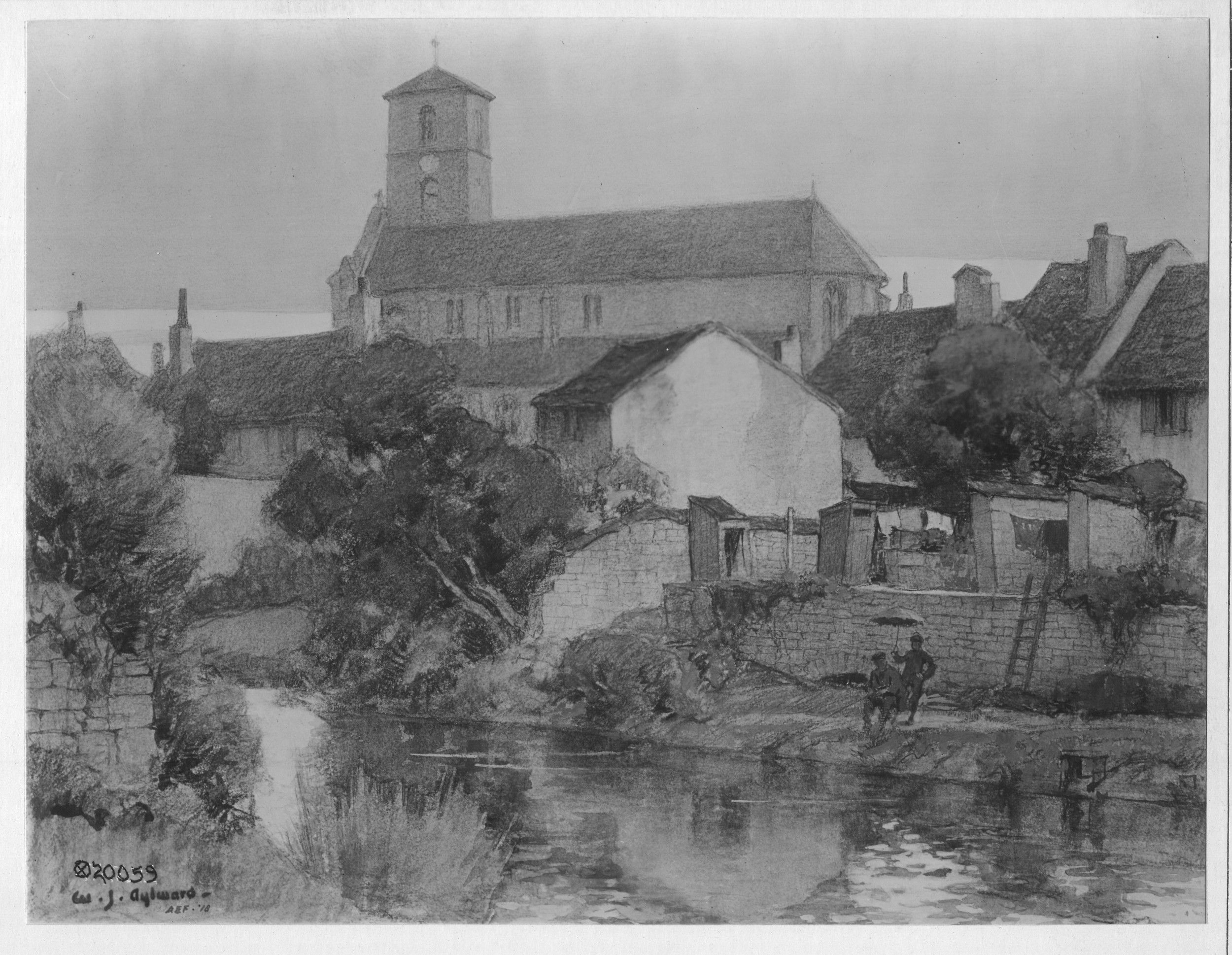
Document
Memo from Captain William E. Moore to Chief, G-2-D
9/23/1918
This primary source comes from the Records of the American Expeditionary Forces (World War I).
National Archives Identifier: 16569308
Full Citation: Memo from Captain William E. Moore to Chief, G-2-D; 9/23/1918; Records of the American Expeditionary Forces (World War I), . [Online Version, https://www.docsteach.org/documents/document/memo-from-captain-william-e-moore-to-chief-g2d, April 20, 2024]Memo from Captain William E. Moore to Chief, G-2-D
Page 1
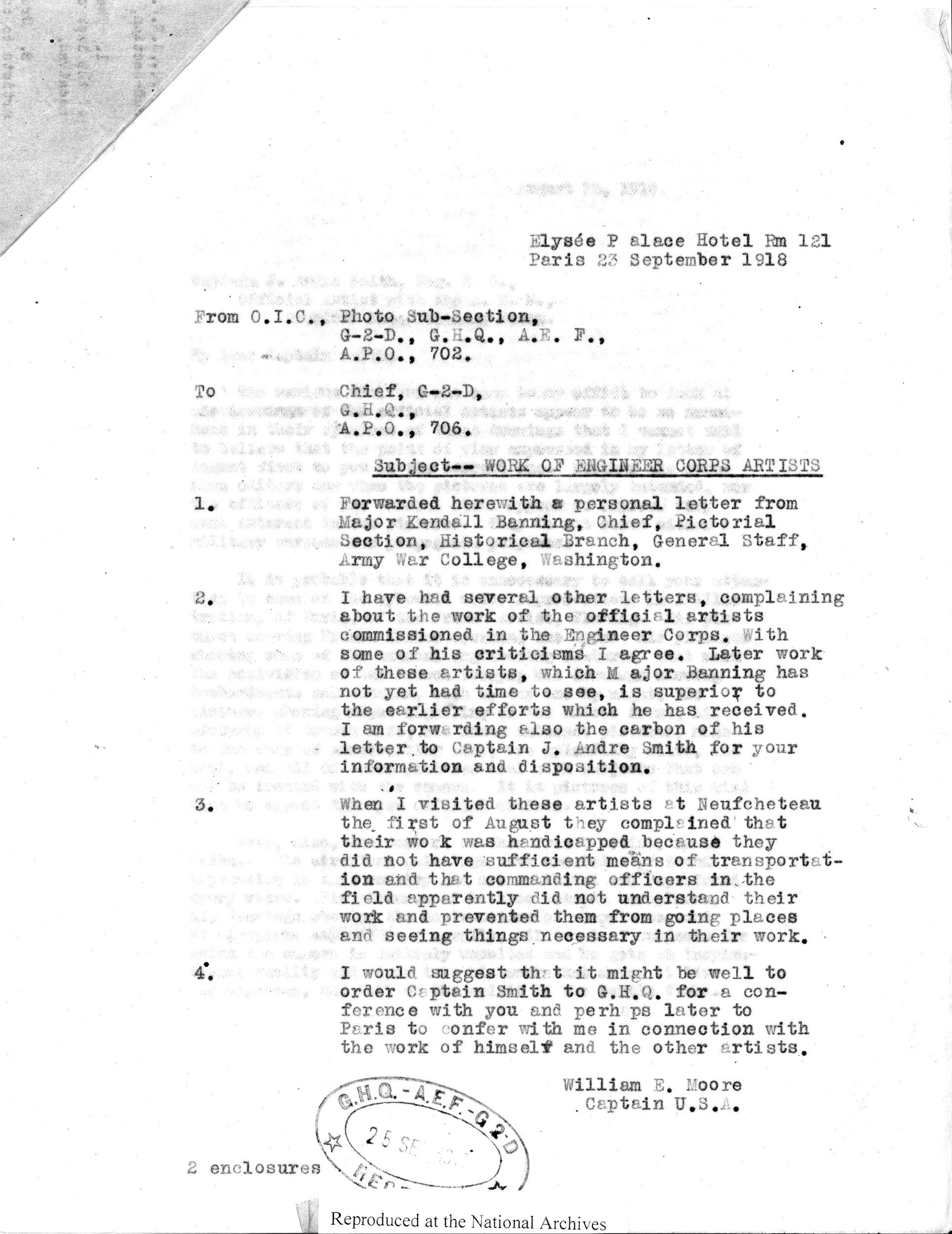
Document
Rough Draft of Memo for Chief of Staff from Pershing
9/11/1918
This primary source comes from the Records of the American Expeditionary Forces (World War I).
National Archives Identifier: 16569294
Full Citation: Rough Draft of Memo for Chief of Staff from Pershing; 9/11/1918; Records of the American Expeditionary Forces (World War I), . [Online Version, https://www.docsteach.org/documents/document/rough-draft-of-memo-for-chief-of-staff-from-pershing, April 20, 2024]Rough Draft of Memo for Chief of Staff from Pershing
Page 1

Document
Doughboy Fighting Through Barbed Wire Entanglements
12/21/1918
During World War I, the U.S. Government’s Committee for Public Information employed artists, who followed troops into France with the American Expeditionary Forces (AEF) during the war. Commissioned as officers in the Corps of Engineers, the artists were assigned to create artwork in a variety of media to show the war to Americans back home.
Official American military artist Captain Harvey Dunn made this drawing.
Official American military artist Captain Harvey Dunn made this drawing.
This primary source comes from the Records of the Office of the Chief Signal Officer.
National Archives Identifier: 12060634
Full Citation: Photograph 111-SC-37906; Doughboy Fighting Through Barbed Wire Entanglements; 12/21/1918; Photographs of American Military Activities, ca. 1918 - ca. 1981; Records of the Office of the Chief Signal Officer, ; National Archives at College Park, College Park, MD. [Online Version, https://www.docsteach.org/documents/document/doughboy-barbed-wire, April 20, 2024]Doughboy Fighting Through Barbed Wire Entanglements
Page 1




